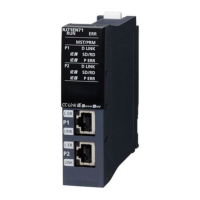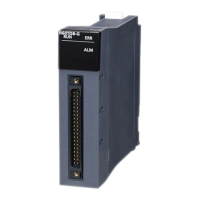25 HIGH-SPEED INPUT/OUTPUT FUNCTION
25.7 PWM Function
331
25
Relationship between cycle and pulse width
The relationship between period and pulse width is shown below.
■When positive logic is set
The relationship between the period and pulse width when the output pulse logic at start of pulse output is set to "Positive
Logic" is shown below. (The pulse width is called the "ON width".)
• When positive logic is set, PWM output begins from output ON.)
• Pulse output is stopped at the specified number of pulses.
• Pulse output stops in the output (Y) status of before PWM output was started.
■When negative logic is set
The relationship between the period and pulse width when the output pulse logic at start of pulse output is set to "Negative
Logic" is shown below. (The pulse width is called the "OFF width".)
• When negative logic is set, PWM output begins when the output pulse turns OFF.
• Pulse output is stopped at the specified number of pulses.
• Pulse output stops in the output (Y) status of before PWM output was started.
PWM driving method
PWM output is driven by either of the following methods.
■Driven by HIOEN/DHIOEN instruction
The logical settings like output destination, cycle, pulse width, output pulse logic, etc. are set in parameters, and the HIOEN/
DHIOEN instruction is used to execute pulse output. For parameters, refer to Page 332 PWM output parameters.
For the HIOEN/DHIOEN instruction, refer to MELSEC iQ-F FX5 Programming Manual (Instructions, Standard Functions/
Function Blocks).
■Driven by PWM/DPWM instruction
The PWM/DPWM instruction is used to execute pulse output.
For the PWM/DPWM instruction, refer to MELSEC iQ-F FX5 Programming Manual (Instructions, Standard Functions/
Function Blocks).
Output pulse
Cycle
PWM output start
(command input)
ON width
Output pulse
OFF width
Cycle
PWM output start
(command input)

